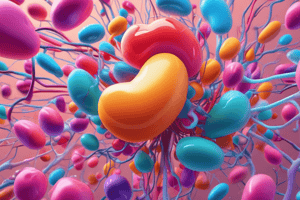Podcast
Questions and Answers
What is the classification of Procainamide?
What is the classification of Procainamide?
What is the mechanism of action of Procainamide?
What is the mechanism of action of Procainamide?
Depresses myocardial excitability, slows conduction of the heart, suppresses ventricular automaticity, increases refractory period, and increases fibrillation threshold.
Which of the following are indications for Procainamide? (Select all that apply)
Which of the following are indications for Procainamide? (Select all that apply)
What are some contraindications for Procainamide? (Select all that apply)
What are some contraindications for Procainamide? (Select all that apply)
Signup and view all the answers
What are the neurological side effects of Procainamide?
What are the neurological side effects of Procainamide?
Signup and view all the answers
What precautions should be taken when using Procainamide?
What precautions should be taken when using Procainamide?
Signup and view all the answers
What can happen if Procainamide is administered too quickly?
What can happen if Procainamide is administered too quickly?
Signup and view all the answers
Class IA sodium channel blockers slow the propagation of impulses down the conduction of the atria and ventricles without affecting the ______ node.
Class IA sodium channel blockers slow the propagation of impulses down the conduction of the atria and ventricles without affecting the ______ node.
Signup and view all the answers
Procainamide decreases the rate of repolarization which results in a widened _______ and prolonged ______ interval.
Procainamide decreases the rate of repolarization which results in a widened _______ and prolonged ______ interval.
Signup and view all the answers
What is the first line drug in the treatment of Ventricular Tachycardia with Pulses?
What is the first line drug in the treatment of Ventricular Tachycardia with Pulses?
Signup and view all the answers
When is Procainamide considered a third line drug?
When is Procainamide considered a third line drug?
Signup and view all the answers
Generally used for ____________ stable monomorphic VT or WPW.
Generally used for ____________ stable monomorphic VT or WPW.
Signup and view all the answers
In general, Class I antiarrhythmics slow conduction in non-_______ tissue and inhibit depolarization.
In general, Class I antiarrhythmics slow conduction in non-_______ tissue and inhibit depolarization.
Signup and view all the answers
Study Notes
Procainamide Overview
- Classification: Antidysrhythmic (Class IA - Sodium Channel Blocker)
- First line treatment: Ventricular Tachycardia with Pulses
Mechanism of Action
- Depresses myocardial excitability and slows heart conduction
- Suppresses ventricular automaticity and increases refractory period, prolonging QRS and QT intervals
- Raises the fibrillation threshold
Indications for Use
- Supraventricular Tachycardia (SVT) associated with Wolff-Parkinson-White (WPW) syndrome
- Ventricular Tachycardia (V-Tach) or Wide Complex Tachycardia
Contraindications
- Hypersensitivity to Procainamide
- Second or third-degree heart blocks
- Digitalis toxicity
- Torsades de Pointes
Side Effects
- Neurological: Seizures, confusion, dizziness, weakness, irritability
- Respiratory: No significant effects noted
- Cardiovascular: Heart blocks, hypotension, ventricular dysrhythmias, widening of QRS, prolonged QT interval
- Other: Nausea and vomiting (N/V)
Precautions
- Patients with myasthenia gravis
- Those with hepatic or renal disease
- Recent myocardial infarction (MI)
- Congestive heart failure (CHF)
- Hypotension and asthma
Drug Interactions
- Concomitant use with antihypertensives may lead to severe hypotension
- Increases effects of neuromuscular blockers, anticholinergics, and antihypertensives
Onset and Duration
- Immediate onset of action, with effects lasting 3-4 hours
Dosage Guidelines
- Administer 20 mg/min IV; maximum of 17 mg/kg, or until symptomatic hypotension or QRS widening by 50% occurs
- Infuse at 2 mg/min if arrhythmia is suppressed
Additional Information
- Class IA sodium channel blockers slow impulse propagation in atria and ventricles without affecting the AV node
- Procainamide decreases rate of repolarization, resulting in widened QRS and prolonged PR interval
- Generally used for hemodynamically stable monomorphic VT or WPW
- Too rapid administration may lead to hypotension
Studying That Suits You
Use AI to generate personalized quizzes and flashcards to suit your learning preferences.
Description
Test your knowledge of Procainamide with these flashcards. Explore its classification, mechanism of action, and clinical indications. Perfect for students mastering pharmacology concepts and antidysrhythmic medications.




